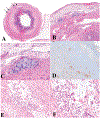What is New in the 2019 World Health Organization (WHO) Classification of Tumors of the Digestive System: Review of Selected Updates on Neuroendocrine Neoplasms, Appendiceal Tumors, and Molecular Testing
- PMID: 32233993
- PMCID: PMC9281538
- DOI: 10.5858/arpa.2019-0665-RA
What is New in the 2019 World Health Organization (WHO) Classification of Tumors of the Digestive System: Review of Selected Updates on Neuroendocrine Neoplasms, Appendiceal Tumors, and Molecular Testing
Abstract
Context.—: The 5th edition of the World Health Organization classification of digestive system tumors discusses several advancements and developments in understanding the etiology, pathogenesis, and diagnosis of several digestive tract tumors.
Objective.—: To provide a summary of the updates with a focus on neuroendocrine neoplasms, appendiceal tumors, and the molecular advances in tumors of the digestive system.
Data sources.—: English literature and personal experiences.
Conclusions.—: Some of the particularly important updates in the 5th edition are the alterations made in the classification of neuroendocrine neoplasms, understanding of pathogenesis of appendiceal tumors and their precursor lesions, and the expanded role of molecular pathology in establishing an accurate diagnosis or predicting prognosis and response to treatment.
Figures







Comment in
-
An incidental rectal neuroendocrine microcarcinoma ('micro-NEC') coexistent with a high grade adenoma.Pathol Int. 2020 May;70(5):300-302. doi: 10.1111/pin.12916. Epub 2020 Feb 20. Pathol Int. 2020. PMID: 32080935 No abstract available.
References
-
- Kim JY, Hong S. Recent updates on neuroendocrine tumors from the gastrointestinal and pancreatobiliary tracts. Arch Pathol Lab Med. 2016;140(5):437–448. - PubMed
-
- Lokuhetty D, White V, Watanabe R, Cree I. WHO classification of tumours of the digestive system. Lyon: International Agency for Research on Cancer; 2018.

